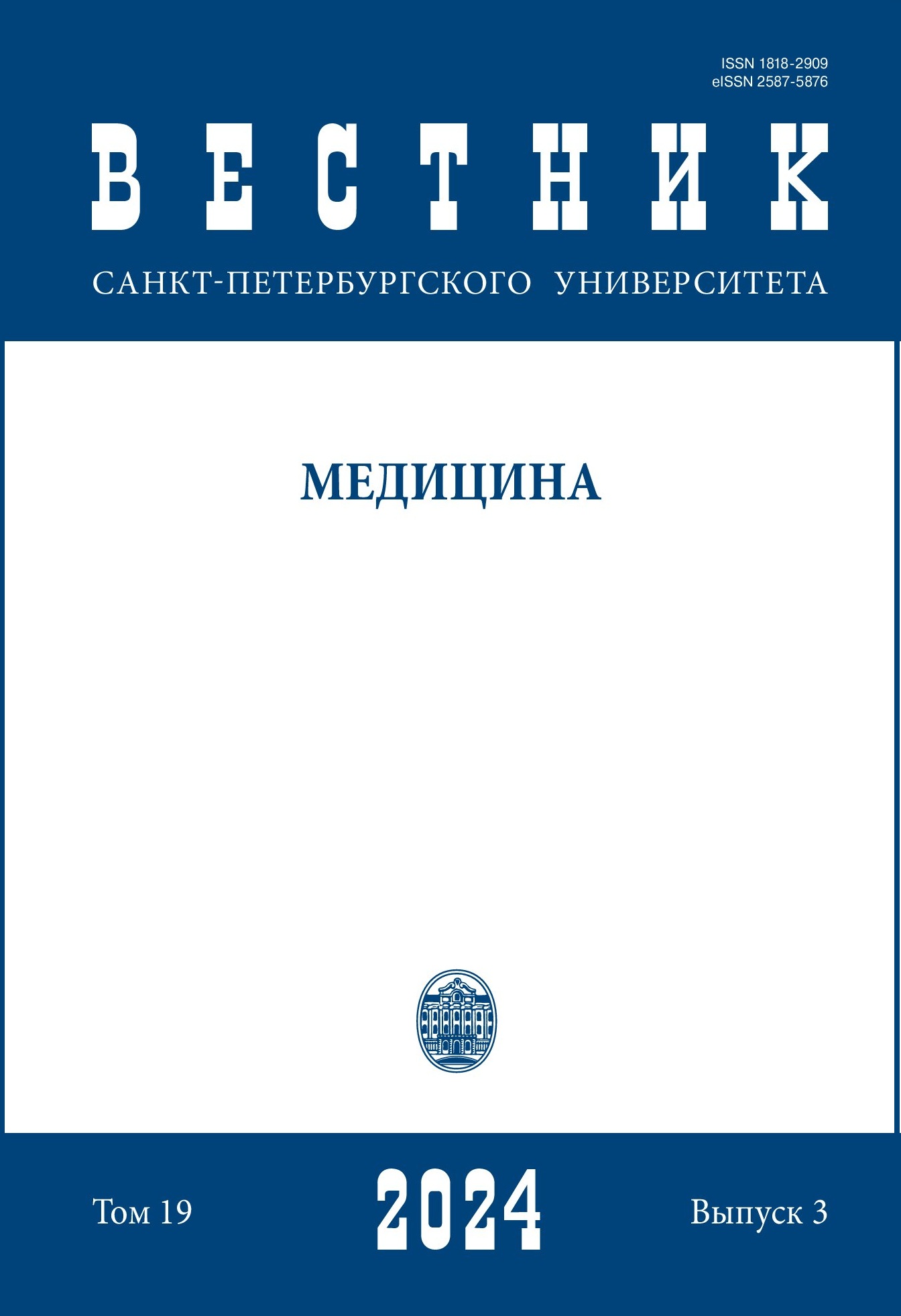Genetic markers of predisposition to monogenic and polygenic obesity
DOI:
https://doi.org/10.21638/spbu11.2024.303Abstract
Genetic markers of obesity play a crucial role in understanding the pathogenesis of this multifactorial disease, which remains one of the major public health challenges of the 21st century. In recent years, numerous genetic variants associated with obesity have been identified thanks to the development of genome-wide association studies (GWAS). Among the most studied genes are FTO, MC4R, TMEM18, NEGR1, and BDNF. Polymorphisms in these genes are linked to various aspects of appetite regulation, metabolism, and fat tissue accumulation.
It is important to note that the integration of data from genome-wide association studies, epigenetic research, and the analysis of external factors represents a promising direction for the development of personalized strategies for the prevention and treatment of obesity. This comprehensive approach will not only enhance our understanding of the molecular mechanisms underlying obesity but also lead to more effective and targeted therapeutic methods that take into account the individual genetic and epigenetic characteristics of patients.
Keywords:
obesity, genetic markers, metabolism, FTO, MC4R, GWAS, body mass index, adipogenesis, insulin, polygenic variants
Downloads
References
Bonnefond A., Froguel P. ; MAGIC Investigators; Hottenga J. J., Prokopenko I., Waite L. L., Harris T. B.,Smith A. V., Shuldiner A. R., McArdle W. L., Caulfield M. J., Munroe P. B., Grön-berg H., Chen Y. D., Li G.,Beckmann J. S., Johnson T., Thorsteinsdottir U., Teder-Laving M., Khaw K. T., Wareham N. J., Zhao J. H.,Amin N., Oostra B. A., Kraja A. T., Province M. A., Cupples L. A., Heard-Costa N. L., Kaprio J., Ripatti S.,Surakka I., Collins F. S., Saramies J., Tuomilehto J., Jula A., Salomaa V., Erdmann J., Hengstenberg C.,Loley C., Schunkert H., Lamina C., Wichmann H. E., Albrecht E., Gieger C., Hicks A. A., Johansson A.,Pramstaller P. P., Kathiresan S., Speliotes E. K., Penninx B., Hartikainen A. L., Jarvelin M. R.,Gyllensten U., Boomsma D. I., Campbell H., Wilson J. F., Chanock S. J., Farrall M., Goel A., Medina-Gomez C., Rivadeneira F., Estrada K., Uitterlinden A. G., Hofman A., Zillikens M. C., den Heijer M.,Kiemeney L. A., Maschio A., Hall P., Tyrer J., Teumer A., Völzke H., Kovacs P., Tönjes A., Mangino M.,Spector T. D., Hayward C., Rudan I., Hall A. S., Samani N. J., Attwood A. P., Sambrook J. G., Hung J.,Palmer L. J., Lokki M. L., Sinisalo J., Boucher G., Huikuri H., Lorentzon M., Ohlsson C., Eklund N.,Eriksson J. G., Barlassina C., Rivolta C., Nolte I.M., Snieder H., Van der Klauw M. M., Van Vliet-Ostaptchouk J. V., Gejman P. V., Shi J., Jacobs K. B., Wang Z., Bakker S. J., Mateo Leach I., Navis G.,van der Harst P., Martin N. G., Medland S. E., Montgomery G. W., Yang J., Chasman D. I., Ridker P. M., Rose L. M., Lehtimäki T., Rai-takari O., Absher D., Iribarren C., Basart H., Hovingh K. G.,Hyppönen E., Power C., Ander-son D., Beilby J. P., Hui J., Jolley J., Sager H., Bornstein S. R., Schwarz P. E.,Kristiansson K., Perola M., Lindström J., Swift A. J., Uusitupa M., Atalay M., Lakka T. A., Rauramaa R.,Bolton J. L., Fowkes G., Fraser R. M., Price J. F., Fischer K., Krjutå Kov K., Metspalu A., Mihailov E.,Langenberg C., Luan J., Ong K. K., Chines P. S., Keinanen-Kiukaanniemi S. M., Saaristo T. E., Edkins S.,Franks P. W., Hallmans G., Shungin D., Morris A. D., Palmer C. N., Erbel R., Moebus S., Nöthen M. M.,Pechlivanis S., Hveem K., Narisu N., Hamsten A., Humphries S. E., Strawbridge R. J., Tremoli E.,Grallert H., Thorand B., Illig T., Koenig W., Müller-Nurasyid M., Peters A., Boehm B. O., Kleber M. E.,März W., Winkelmann B. R., Kuusisto J., Laakso M., Arveiler D., Cesana G., Kuulasmaa K., Virtamo J.,Yarnell J. W., Kuh D., Wong A., Lind L., de Faire U., Gigante B., Magnusson P. K., Pedersen N. L.,Dedoussis G., Dimitriou M., Ko-lovou G., Kanoni S., Stirrups K., Bonnycastle L. L., Njølstad I.,Wilsgaard T., Ganna A., Rehnberg E., Hingorani A., Kivimaki M., Kumari M., Assimes T. L., Barroso I.,Boehnke M., Borecki I. B., Deloukas P., Fox C. S., Frayling T., Groop L. C., Haritunians T., Hunter D.,Ingelsson E., Kaplan R., Mohlke K. L., O’Connell J. R., Schlessinger D., Strachan D. P., Stefansson K.,van Duijn C. M., Abecasis G. R., McCarthy M. I., Hirschhorn J. N., Qi L., Loos R. J., Lindgren C. M.,North K. E., Heid I. M. Sex-stratified genome-wide association studies including 270,000 individuals show sexual dimorphism in genetic loci for anthro-pometric traits // PLoS Genet. 2013. Vol. 9, no. 6.P. e1003500. https://doi.org/10.1371/journal.pgen.1003500
References
Downloads
Published
How to Cite
Issue
Section
License
Articles of "Vestnik of Saint Petersburg University. Medicine" are open access distributed under the terms of the License Agreement with Saint Petersburg State University, which permits to the authors unrestricted distribution and self-archiving free of charge.




